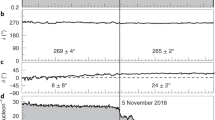Abstract
A possible dynamo mechanism beyond the heliopause is proposed to explain the increase in the magnetic field without change in its direction, which was observed by the Voyager 1 and Voyager 2 space probes upon crossing the heliospheric boundary. The necessary conditions for the dynamo realization are listed and it is shown that they are fulfilled beyond the heliopause. The fulfillment of the necessary conditions does not guarantee the realization of the dynamo mechanism, but it creates the prerequisites for it. The paper is based on the report made at the conference “Ideas of S.B. Pikelner and S.A. Kaplan and Modern Astrophysics” (Sternberg Astronomical Institute, Moscow State University, February 8–12, 2021).

Similar content being viewed by others
REFERENCES
L. F. Burlaga, N. F. Ness, and E. C. Stone, Science (Washington, DC, U. S.) 341, 147 (2013).
D. A. Gurnett, W. S. Kurth, L. F. Burlaga, and N. F. Ness, Science (Washington, DC, U. S.) 341, 1489 (2013).
S. M. Krimigis, R. B. Decker, E. C. Roelof, M. E. Hill, C. O. Bostrom, K. Dialynas, G. Gloeckler, D. C. Hamilton, E. P. Keath, and L. J. Lanzerotti, Nat. Astron. 3, 997 (2019).
W. R. Webber and F. B. McDonald, Geophys. Res. Lett. 40, 1665 (2013).
M. Opher and J. F. Drake, Astrophys. J. Lett. 778, L26 (2013).
E. S. Belenkaya, Solar Phys. 290, 2077 (2015).
E. S. Belenkaya, in Electric Currents in Geospace and Beyond, Ed. by A. Keiling, O. Marghitu, and M. Wheatland, AGU Geophys. Monograph Ser. 235, 207 (2018).
L. F. Burlaga, N. F. Ness, D. B. Berdichevsky, J. Park, L. K. Jian, A. Szabo, E. C. Stone, and J. D. Richardson, Nat. Astron. 3, 1007 (2019).
J. D. Richardson, J. W. Belcher, P. Garcia-Galindo, and L. F. Burlaga, Nat. Astron. 3, 1019 (2019).
L. Burlaga, J. Phys.: Conf. Ser. 642, 012003 (2015).
E. S. Belenkaya and M. L. Khodachenko, Int. J. Astron. Astrophys. 2, 81 (2012).
E. S. Belenkaya, M. L. Khodachenko, and I. I. Alexeev, in Characterizing Stellar and Exoplanetary Environments, Ed. by H. Lammer and M. Khodachenko, Astrophys. Space Sci. Libr. 411, 239 (2015).
W. M. Elsasser, J. Geophys. Res. 61, 340 (1956).
J. J. Quenby and W. R. Webber, Mon. Not. R. Astron. Soc. 453, 1297 (2015).
F. Fraternale, N. V. Pogorelov, J. D. Richardson, and D. Tordella, Astrophys. J. 872, 40 (2019).
H. K. Moffat, Magnetic Field Generation in Electrically Conducting Fluids (Cambridge Univ. Press, Cambridge, 1978).
V. B. Baranov and H. J. Fahr, J. Geophys. Res. 108 (A3), 1110 (2003).
I. I. Alexeev, J. Geomagn. Geoelectr. 38, 1199 (1986).
I. I. Alexeev and V. V. Kalegaev, J. Geophys. Res. 100, 19267 (1995).
M. Witte, Astron. Astrophys. 426, 835 (2004).
I. I. Alexeev, A. P. Kropotkin, and I. S. Veselovsky, Solar Phys. 79, 385 (1982).
E. N. Parker, Astrophys. J. 401, 137 (1992).
P. C. Frisch, A. Berdyugin, H. O. Funsten, A. M. Ma-galhaes, et al., J. Phys.: Conf. Ser. 577, 012010 (2014).
N. A. Schwadron, F. C. Adams, E. Christian, P. Desiati, et al., J. Phys.: Conf. Ser. 531, 012010 (2014).
A. Shluter and L. Biermann, Z. Naturforsh. 5a, 237 (1950).
S. I. Vainshtein and Ya. B. Zel’dovich, Sov. Phys. Usp. 15, 159 (1972).
D. A. Gurnett and W. S. Kurth, Nat. Astron. 3, 1024 (2019).
G. P. Zank, Ann. Rev. Astron. Astrophys. 53, 449 (2015).
L. F. Burlaga and N. F. Ness, Astrophys. J. 829, 134 (2016).
L. D. Landau and E. M. Lifshitz, Course of Theoretical Physics, Vol. 8: Electrodynamics of Continuous Media (Nauka, Moscow, 1982; Pergamon, New York, 1984).
L. F. Burlaga, W. S. Kurth, D. A. Gurnett, D. B. Berdichevsky, L. K. Jian, N. F. Ness, J. Park, and A. Szabo, Astrophys. J. 911, 61 (2021).
Funding
The author is grateful to the Government of the Russian Federation and the Ministry of Higher Education and Science of the Russian Federation for the support (grant no. 075-15-2020-780 (N13.1902.21.0039)).
Author information
Authors and Affiliations
Corresponding author
Additional information
Translated by M. Chubarova
Rights and permissions
About this article
Cite this article
Belenkaya, E.S. Dynamo beyond the Heliopause: Verification from the Available Data of Voyager 2. Astron. Rep. 65, 1145–1149 (2021). https://doi.org/10.1134/S1063772921110044
Received:
Revised:
Accepted:
Published:
Issue Date:
DOI: https://doi.org/10.1134/S1063772921110044




